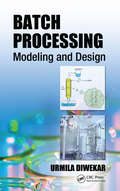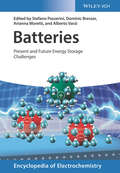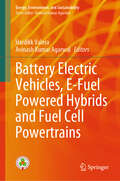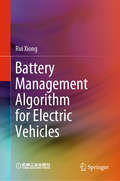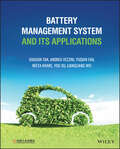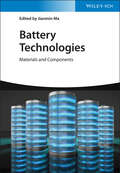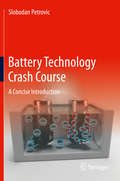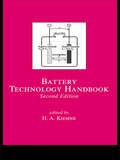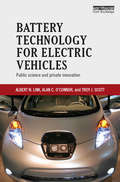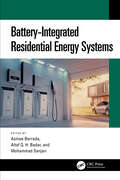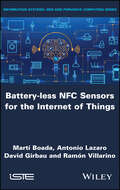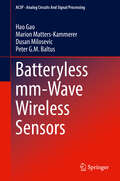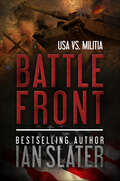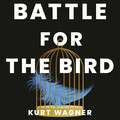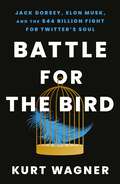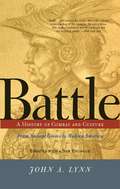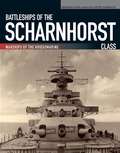- Table View
- List View
Batch Processing: Modeling and Design
by Urmila DiwekarBatch processes are widely used in pharmaceutical, food, and specialty chemicals where high value, low volume products are manufactured. Designing these processes and unit operations can be an onerous task that requires computational efforts. With examples, case studies, and more than 100 homework problems, this book presents an overview of computer-aided design packages and describes the unit operations in batch and bioprocessing. Providing students with a thorough grounding in the numerical methods necessary to solve design problems, it discusses the basics of design, modeling, and optimization. Figure slides are available upon qualifying course adoption.
Batterien: Grundlagen, Systeme, Anwendungen
by Heinz Wenzl Alexander BörgerBatterien Für die Mobilität und Energieversorgung der Zukunft: Kompakte und praxisnahe Wissensvermittlung aller wichtigen Batteriegrundlagen und -systeme Batterien sind in vielen Fällen die bevorzugte Lösung zur technischen und wirtschaftlichen Optimierung von Fahrzeugen und Energieversorgungsystemen und ermöglichen es, Emissionen zu verringern und die Abhängigkeit von Erdöl und Erdgas zu reduzieren. In der Summe aller Eigenschaften erfüllen Blei-Säure-Batterien und Lithium-Ionen-Batterien die Anforderungen der verschiedensten Anwendungen am besten und dominieren deshalb den Markt. Lithium-Ionen-Batterien dringen in immer weitere Anwendungsgebiete vor, bzgl. Wert und Produktionsmenge in MWh dominieren aber immer noch Blei-Säure-Batterien. Aus Sicht der Autoren sind Kenntnisse beider Batterietechnologien wichtig, um das Verständnis für Batteriesysteme zu vertiefen und sie in den seltenen Fällen, in denen diese beiden Batterietechnologien technische oder wirtschaftliche Alternativen sind, gegeneinander abzuwägen. Die Anforderungen an Batteriesysteme sind hoch. Sie müssen leicht und häufig ladbar sein und müssen thermisch, elektrisch und mechanisch stabil sein. In der Batterieforschung kommt materialwissenschaftliches, elektrochemisches und Ingenieurwissen zusammen. Die Autoren Alexander Börger und Heinz Wenzl geben mit diesem Buch einen umfassenden und kompakten Überblick zu den Grundlagen, Systemen und Anwendungen der Batterietechnik. Es werden Hintergründe zum Aufbau von Batterien und grundlegende Prozesse anschaulich erläutert. Anhand vieler Beispiele wird gezeigt, wie das Wissen in die Praxis umgesetzt wird. Klarer Fokus: Das Buch legt den Schwerpunkt auf Batteriesysteme, ihre Eigenschaften im Betrieb und Anwendungen. Das Buch ist als Begleitlektüre zum Studium verwendbar. Wachstumsmarkt: Das Interesse an Elektromobilität und Batteriespeichern in der Stromversorgung wächst und damit auch der Bedarf an Batteriesystemen. Anwendungsnah: Fallbeispiele aus der aktuellen Batterieentwicklung setzen die Theorie in die Praxis um. Expertenwissen: Die Autoren verfügen über langjährige Erfahrung auf dem Gebiet der Batterietechnik. Batterien: Grundlagen, Systeme, Anwendungen richtet sich an Ingenieurinnen und Ingenieure zur Einarbeitung in die Materie und als Nachschlagewerk sowie an Studierende als Begleitlektüre zu Vorlesungen.
Batteries for Electric Vehicles
by Helena BergThis fundamental guide will teach you the basics of battery design for electric vehicles. Working through this book, you will understand how to optimise battery performance and functionality, whilst minimising costs and maximising durability. Beginning with the basic concepts of electrochemistry, the author moves on to describe implementation, control and management of batteries in real vehicles, with respect to the battery materials. The author describes how to select cells and batteries with explanations of the advantages and disadvantages of different battery chemistries, enabling you to put your knowledge into practice and make informed and successful design decisions, with a thorough understanding of the trade-offs involved. The first of its kind, and written by an industry expert with experience in academia, this is an ideal resource for both students and researchers in the fields of battery research and development as well as for professionals in the automotive industry extending their interest towards electric vehicles.
Batteries for Sustainability: Selected Entries from the Encyclopedia of Sustainability Science and Technology
by Ralph J. BroddBatteries that can store electricity from solar and wind generation farms are a key component of a sustainable energy strategy. Featuring 15 peer-reviewed entries from the Encyclopedia of Sustainability Science and Technology, this book presents a wide range of battery types and components, from nanocarbons for supercapacitors to lead acid battery systems and technology. Worldwide experts provides a snapshot-in-time of the state-of-the art in battery-related R&D, with a particular focus on rechargeable batteries. Such batteries can store electrical energy generated by renewable energy sources such as solar, wind, and hydropower installations with high efficiency and release it on demand. They are efficient, non-polluting, self-contained devices, and their components can be recovered and used to recreate battery systems. Coverage also highlights the significant efforts currently underway to adapt battery technology to power cars, trucks and buses in order to eliminate pollution from petroleum combustion. Written for an audience of undergraduate and graduate students, researchers, and industry experts, Batteries for Sustainability is an invaluable one-stop reference to this essential area of energy technology.
Batteries: Present and Future Energy Storage Challenges (Encyclopedia of Electrochemistry)
by Stefano PasseriniPart of the Encyclopedia of Electrochemistry, this comprehensive, two-volume handbook offers an up-to-date and in-depth review of the battery technologies in use today. It also includes information on the most likely candidates that hold the potential for further enhanced energy and power densities. It contains contributions from a renowned panel of international experts in the field. Batteries are extremely commonplace in modern day life. They provide electrochemically stored energy in the form of electricity to automobiles, aircrafts, electronic devices and to smart power grids. Comprehensive in scope, 'Batteries' covers information on well-established battery technologies such as charge-carrier-based lead acid and lithium ion batteries. The contributors also explore current developments on new technologies such as lithium-sulfur and -oxygen, sodium ion, and full organic batteries. Written for electrochemists, physical chemists, and materials scientists, 'Batteries' is an accessible compendium that offers a thorough review of the most relevant current battery technologies and explores the technology in the years to come.
Battery Electric Vehicles, E-Fuel Powered Hybrids and Fuel Cell Powertrains (Energy, Environment, and Sustainability)
by Avinash Kumar Agarwal Hardikk ValeraThis book explores advanced powertrain technologies aimed at reducing greenhouse gas (GHG) emissions and accelerating the transition to sustainable mobility. As regulatory bodies push for alternatives to internal combustion engines (ICEs), battery electric vehicles (BEVs), hybrid electric vehicles (HEVs), plug-in hybrid electric vehicles (PHEVs), and fuel cell-based powertrains are emerging as viable solutions. However, challenges such as battery safety, thermal management, and fuel cell efficiency require further research and innovation. This book presents state-of-the-art developments in lithium-ion batteries, fuel cell modeling, battery thermal management systems (BTMSs), and electro-catalyst advancements for fuel cell transportation. It also discusses the technological, environmental, and regulatory challenges associated with electrified powertrains. By providing insights into recent advancements and future prospects, this book serves as a valuable resource for researchers, engineers, and policymakers striving to develop efficient and sustainable vehicle technologies.
Battery Management Algorithm for Electric Vehicles
by Rui XiongThis book systematically introduces readers to the core algorithms of battery management system (BMS) for electric vehicles. These algorithms cover most of the technical bottlenecks encountered in BMS applications, including battery system modeling, state of charge (SOC) and state of health (SOH) estimation, state of power (SOP) estimation, remaining useful life (RUL) prediction, heating at low temperature, and optimization of charging. The book not only presents these algorithms, but also discusses their background, as well as related experimental and hardware developments. The concise figures and program codes provided make the calculation process easy to follow and apply, while the results obtained are presented in a comparative way, allowing readers to intuitively grasp the characteristics of different algorithms. Given its scope, the book is intended for researchers, senior undergraduate and graduate students, as well as engineers in the fields of electric vehicles and energy storage.
Battery Management System and its Applications
by Xiaojun Tan Andrea Vezzini Yuqian Fan Neeta Khare You Xu Liangliang WeiBATTERY MANAGEMENT SYSTEM AND ITS APPLICATIONS Enables readers to understand basic concepts, design, and implementation of battery management systems Battery Management System and its Applications is an all-in-one guide to basic concepts, design, and applications of battery management systems (BMS), featuring industrially relevant case studies with detailed analysis, and providing clear, concise descriptions of performance testing, battery modeling, functions, and topologies of BMS. In Battery Management System and its Applications, readers can expect to find information on: Core and basic concepts of BMS, to help readers establish a foundation of relevant knowledge before more advanced concepts are introduced Performance testing and battery modeling, to help readers fully understand Lithium-ion batteries Basic functions and topologies of BMS, with the aim of guiding readers to design simple BMS themselves Some advanced functions of BMS, drawing from the research achievements of the authors, who have significant experience in cross-industry research Featuring detailed case studies and industrial applications, Battery Management System and its Applications is a must-have resource for researchers and professionals working in energy technologies and power electronics, along with advanced undergraduate/postgraduate students majoring in vehicle engineering, power electronics, and automatic control.
Battery Technologies: Materials and Components
by Jianmin MaBattery Technologies A state-of-the-art exploration of modern battery technology In Battery Technologies: Materials and Components, distinguished researchers Dr. Jianmin Ma delivers a comprehensive and robust overview of battery technology and new and emerging technologies related to lithium, aluminum, dual-ion, flexible, and biodegradable batteries. The book offers practical information on electrode materials, electrolytes, and the construction of battery systems. It also considers potential approaches to some of the primary challenges facing battery designers and manufacturers today. Battery Technologies: Materials and Components provides readers with: A thorough introduction to the lithium-ion battery, including cathode and anode materials, electrolytes, and binders Comprehensive explorations of lithium-oxygen batteries, including battery systems, catalysts, and anodes Practical discussions of redox flow batteries, aqueous batteries, biodegradable batteries, and flexible batteries In-depth examinations of dual-ion batteries, aluminum ion batteries, and zinc-oxygen batteries Perfect for inorganic chemists, materials scientists, and electrochemists, Battery Technologies: Materials and Components will also earn a place in the libraries of catalytic and polymer chemists seeking a one-stop resource on battery technology.
Battery Technology Crash Course: A Concise Introduction
by Slobodan PetrovicThis book is a concise introductory guide to understanding the field of modern batteries, which is fast becoming an important area for applications in renewable energy storage, transportation, and consumer devices. By using simplified classroom-tested methods developed while teaching the subject to engineering students, the author explains in simple language an otherwise complex subject in terms that enable readers to gain a rapid understanding of batteries and the scientific and engineering concepts and principles behind the technology. This powerful tutorial is a great resource for engineers from other disciplines, technicians, analysts, investors, and other busy professionals who need to quickly acquire a solid understanding of the fast emerging and disruptive battery landscape.
Battery Technology Handbook (Electrical Engineering And Electronics Ser. #Vol. 118)
by H.A. KiehneThis practical reference remains the most comprehensive guide to the fundamental theories, techniques, and strategies used for battery operation and design. It includes new and revised chapters focusing on the safety, performance, quality, and enhancement of various batteries and battery systems. From automotive, electrochemical, and high-energy applications to system implementation, selection, and standardization, the Second Edition presents expert discussions on electrochemical energy storage, the advantages of battery-powered traction, the disposal and recycling of used batteries, hazard prevention, and the chemistry and physics of lithium primary batteries.
Battery Technology for Electric Vehicles: Public science and private innovation
by Albert N. Link Alan C. O'Connor Troy J. ScottElectric drive vehicles (EDVs) are seen on American roads in increasing numbers. Related to this market trend and critical for it to increase are improvements in battery technology. Battery Technology for Electric Vehicles examines in detail at the research support from the U.S. Department of Energy (DOE) for the development of nickel-metal-hydride (NiMH) and lithium-ion (Li-ion) batteries used in EDVs. With public support comes accountability of the social outcomes associated with public investments. The book overviews DOE investments in advanced battery technology, documents the adoption of these batteries in EDVs on the road, and calculates the economic benefits associated with these improved technologies. It provides a detailed global evaluation of the net social benefits associated with DOEs investments, the results of the benefit-to-cost ratio of over 3.6-to-1, and the life-cycle approach that allows adopted EDVs to remain on the road over their expected future life, thus generating economic and environmental health benefits into the future.
Battery-Integrated Residential Energy Systems
by Asmae Berrada Badar, Altaf Q. H. Mohammad SanjariBattery-Integrated Residential Energy Systems introduces battery energy storage systems (BESS) of residential systems and offers insight into modeling, managing, and controlling them. Apart from survey of different BESS applications, it explains electrochemical simulation models of BESS. It includes performance parameters, economic analysis, sizing, energy management, control, charging and discharging patterns, coordination of the storage system with other devices in the home, and policy-related matters.Features: Covers different aspects of smart residential energy systems with a battery as a key element Discusses increasing energy efficiency in residential units by optimal control and management of BESS Explores information related to the policy regarding the use of BESS Includes chapters on energy trading for implementation of optimal energy management of BESS Focuses on a variety of aspects of battery operation and control This book is aimed at senior undergraduate, graduate students, and researchers in Electrical Engineering, Battery Systems, Energy Engineering, and Sustainable and Renewable Technologies.
Battery-less NFC Sensors for the Internet of Things
by Martí Boada Antonio Lazaro David Girbau Ramón VillarinoThe implementation of near-field communication (NFC) technology in smartphones has grown rapidly, especially due to the use of this technology as a payment system. In addition, the ability to use the energy transmitted not only for communication, but also for feeding other devices, which together with the low cost of NFC chips and the internet connectivity of the smartphones, allows the design of battery-less RF tags with sensing capabilities, whose information can be sent to the cloud. This is of great interest in the increasing amount of IoT (Internet of Things) scenarios. This book studies the feasibility of these sensors, analyzing the different parameters that have an influence on performance and in the range of operation. It also presents techniques to increase the range and analyzes the effects of certain materials when they are close to the antenna. The design and analysis of several sensors that can be powered and read by any NFC enabled device are presented in this work.
Batteryless mm-Wave Wireless Sensors (Analog Circuits and Signal Processing)
by Dusan Milosevic Hao Gao Marion Matters-Kammerer Peter G.M. BaltusThis book describes the PREMISS system, which enables readers to overcome the limitations of state-of-the-art battery-less wireless sensors in size, cost, robustness and range, with a system concept for a 60 GHz wireless sensor system with monolithic sensors. The authors demonstrate a system in which the wireless sensors consist of wireless power receiving, sensing and communication functions in a single chip, without external components, avoiding costly IC-interfaces that are sensitive to mechanical and thermal stress.
Battle Front (USA vs. Militia)
by Ian SlaterThe final collapse of trust between the ruled and the rulers has happened in an America where civil war rages again. From bestselling author Ian Slater. "As impelling a storyteller as you're likely to encounter."—Clive Cussler The Federals drew first blood as battalions of freedom fighters went tank-to-tank with the National Guard in the Northwest. Though the President declares the area secure, top officials know the truth: The Militia movement is spreading from the fringes like wildfire, now more organized, committed, and violent than ever, and hellbent on an armed victory over the United States. No matter how desperately the government tries to regain its hold, the roads of America are shuddering under the columns of tanks, the skies throbbing with Blackhawks. Two hundred thousand trained militiamen are armed with high-tech killing tools and the courage of true believers. And after a spark ignites the Everglades, the USA takes the most explosive hit of all.
Battle Tactics of the Western Front
by Paddy GriffithHistorians have portrayed British participation in World War I as a series of tragic debacles, with lines of men mown down by machine guns, with untried new military technology, and incompetent generals who threw their troops into improvised and unsuccessful attacks. In this book a renowned military historian studies the evolution of British infantry tactics during the war and challenges this interpretation, showing that while the British army's plans and technologies failed persistently during the improvised first half of the war, the army gradually improved its technique, technology, and, eventually, its' self-assurance. By the time of its successful sustained offensive in the fall of 1918, says Paddy Griffith, the British army was demonstrating a battlefield skill and mobility that would rarely be surpassed even during World War II.Evaluating the great gap that exists between theory and practice, between textbook and bullet-swept mudfield, Griffith argues that many battles were carefully planned to exploit advanced tactics and to avoid casualties, but that breakthrough was simply impossible under the conditions of the time. According to Griffith, the British were already masters of "storm troop tactics" by the end of 1916, and in several important respects were further ahead than the Germans would be even in 1918. In fields such as the timing and orchestration of all-arms assaults, predicted artillery fire, "Commando-style" trench raiding, the use of light machine guns, or the barrage fire of heavy machine guns, the British led the world. Although British generals were not military geniuses, says Griffith, they should at least be credited for effectively inventing much of the twentieth-century's art of war.
Battle for the Bird: Jack Dorsey, Elon Musk and the $44 Billion Fight for Twitter's Soul
by Kurt WagnerThe gripping corporate saga of Twitter's titans and their journey towards power, innovation, and controversy.'Comprehensive . . . a definitive history' The Times'Battle For The Bird is an absolute triumph of reporting and storytelling.' Ashlee Vance, bestselling author of Elon Musk'If you want to understand how one of the most powerful social networks in history managed to be such a dramatic corporate disaster, you must read Kurt Wagner's deeply reported inside story.' Sarah Frier, author of Financial Times and McKinsey 2020 Business Book of the Year No Filter: The Inside Story of Instagram__________On October 28th, hours after completing a $44 billion takeover of Twitter, Elon Musk Tweeted to his millions of followers 'The bird is freed.'Musk's takeover of Twitter was one of the most audacious and remarkable deals in tech history. The Battle for Twitter takes readers back to the very beginning and how we reached this point. It looks at the origins of the platform, the vision of its co-founder Jack Dorsey, and how it became a battleground for ideas, controversies, and viral moments that shaped the world we live in today.With meticulous research and unprecedented access, author Kurt Wagner paints a vivid portrait of power struggles, bitter rivalries, and ground-breaking decisions that have shaped the evolution of Twitter. From Musk's audacious tweets to Dorsey's enigmatic persona, Battle for The Bird uncovers the depths of their involvement, revealing the forces that have propelled them to the forefront of global attention. In this gripping corporate saga, delve into the minds of these visionary figures as they engage in a high-stakes battle for dominance, reshaping the very fabric of social media.__________
Battle for the Bird: Jack Dorsey, Elon Musk and the $44 Billion Fight for Twitter's Soul
by Kurt WagnerOn October 28th, hours after completing a $44 billion takeover of Twitter, Elon Musk Tweeted to his millions of followers 'The bird is freed.'Musk's takeover of Twitter was one of the most audacious and remarkable deals in tech history. The Battle for Twitter takes readers back to the very beginning and how we reached this point. It looks at the origins of the platform, the vision of its co-founder Jack Dorsey, and how it became a battleground for ideas, controversies, and viral moments that shaped the world we live in today.With meticulous research and unprecedented access, author Kurt Wagner paints a vivid portrait of power struggles, bitter rivalries, and ground-breaking decisions that have shaped the evolution of Twitter. From Musk's audacious tweets to Dorsey's enigmatic persona, The Battle for Twitter uncovers the depths of their involvement, revealing the forces that have propelled them to the forefront of global attention. In this gripping corporate saga, delve into the minds of these visionary figures as they engage in a high-stakes battle for dominance, reshaping the very fabric of social media.
Battle of the Blanket Forts: A QUIX Book (Fort Builders Inc. #3)
by Dee RomitoWhen kids of Fort Builders, Inc., go to summer camp, a friendly blanket fort competition turns serious in the third story in the fun-to-read Aladdin QUIX chapter book series that&’s perfect for emerging readers!Kiara is super excited to go to Camp Firefly for the summer and be with all her friends, including the rest of Fort Builders, Inc. And this year, she can&’t wait to enter the camp-wide CREATE contest. One lucky team will win the prize of building something from scratch, using all the DIY skills they show in the competition. Kiara and her cabin decide compete by making the best blanket fort ever—but Caleb and his cabin decide to do the same thing! Can they learn to work together, or will this epic blanket fort battle turn into an all-out cabin war?
Battle: A History of Combat and Culture
by John A LynnBattle: A History of Combat and Culture spans the globe and the centuries to explore the way ideas shape the conduct of warfare. Drawing its examples from Europe, the Middle East, South Asia, East Asia, and America, John A. Lynn challenges the belief that technology has been the dominant influence on combat from ancient times to the present day. In battle, ideas can be more far more important than bullets or bombs. Carl von Clausewitz proclaimed that war is politics, but even more basically, war is culture. The hard reality of armed conflict is formed by - and, in turn, forms - a culture's values, assumptions, and expectations about fighting. The author examines the relationship between the real and the ideal, arguing that feedback between the two follows certain discernable paths. Battle rejects the currently fashionable notion of a "Western way of warfare" and replaces it with more nuanced concepts of varied and evolving cultural patterns of combat. After considering history, Lynn finally asks how the knowledge gained might illuminate our understanding of the war on terrorism.
Battleships of the Scharnhorst Class: The Scharnhorst and Gneisenau: The Backbone of the German Surface Forces at the Outbreak of War (Warships Of The Kriegsmarine Ser.)
by Gerhard Koop Klaus-Peter SchmolkeIn this WWII naval history, an expert in German warship design examines the legendary battlecruisers Scharnhorst and Gneisenau. This concise yet authoritative summary of Scharnhorst class vessels covers the design history and careers of these WWII-era warships. Much like its companion volume, Battleships of the Bismark Class, it offers a detailed description of both ships with full technical details. The author also provides an outline of their combat service, heavily illustrated with plans, battle maps, and a substantial collection of photographs. The Scharnhorst and Gneisenau were the product of a long and complicated design process. Combining speed and power, these two battleships took part in a number of major operations, including the infamous &‘Channel Dash&’.
Battling Air and Water Pollution: Protecting Our Planet's Vital Resources
by Vir Singh R. K. Srivastava Arvind Kumar BhattThis book discusses growing environmental threats posed by air and water pollution, exploring their causes, impacts, and potential solutions. It covers a range of pollutants, from solid and liquid to gaseous and energy-based, while offering a clear analysis of their origins and effects. The chapters examine the global impact of pollution, highlighting the interconnectedness of air and water pollution and their combined effects on ecosystems and human health. It also discusses economic, social, and health-related costs along with practical solutions for pollution management. This book serves as a valuable resource for environmentalists, policymakers, graduate and postgraduate students, as well as anyone looking to deepen their understanding of environmental challenges.
Battling Malaria: Strengthening The U.s. Military Malaria Vaccine Program
by Institute of Medicine of the National AcademiesThe National Academies Press (NAP)--publisher for the National Academies--publishes more than 200 books a year offering the most authoritative views, definitive information, and groundbreaking recommendations on a wide range of topics in science, engineering, and health. Our books are unique in that they are authored by the nation's leading experts in every scientific field.
Bau-Projektmanagement für Einsteiger: Aufgaben - Projektorganisation - Projektablauf
by Sven SchirmerHeutige Bauprojekte kommen ohne Bau- bzw. Projektleitung nicht aus. Die Aufgabenstellungen werden immer komplexer und umfangreicher, sodass qualifiziertes Personal mit fundiertem Know-How unerlässlich ist. Dieses Fachbuch vermittelt zukünftigen aber auch bereits im Projektmanagement tätigen Praktikern und Bauleitern eine Übersicht über die Aufgabenfelder des Projektmanagers auf der Baustelle. Ein besonderer Schwerpunkt bildet dabei der Umgang mit den Baubeteiligten und die Kommunikation untereinander. Die Aufgabenbereiche und die Einzelthemen im Buch sind im Sinne des Bauablaufs aufgebaut. Die Themen sind so aufbereitet, dass ein solides Grundwissen geschaffen wird. Praktische Hinweise für die tägliche Arbeit auf der Baustelle runden das Werk ab.
